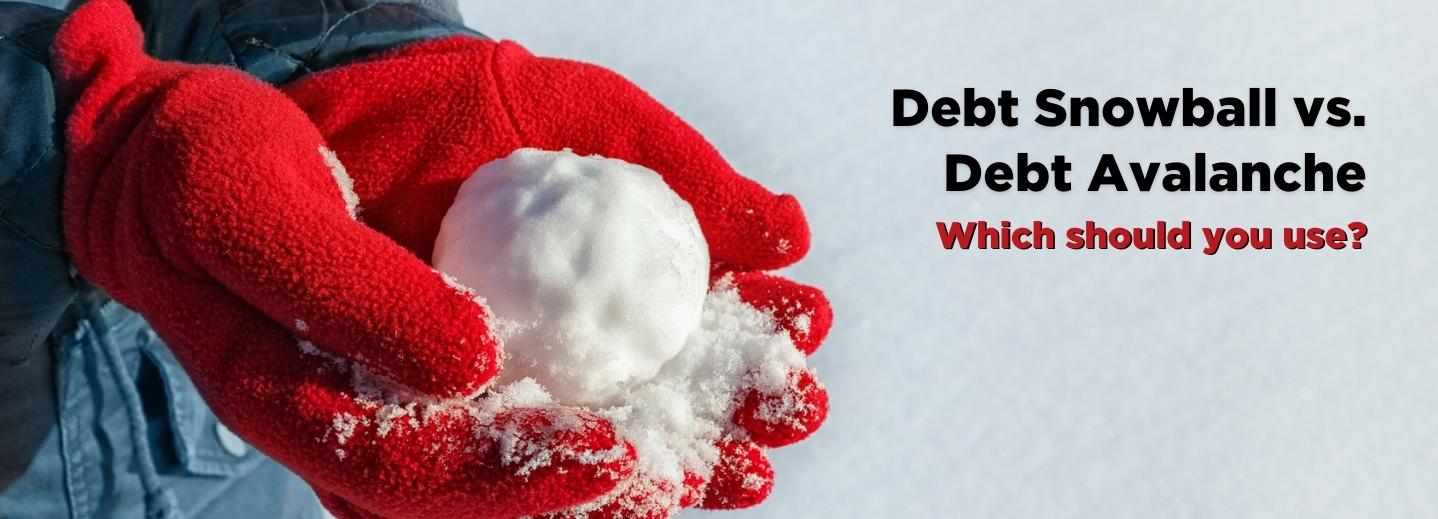Debt Snowball vs. Debt Avalanche: Which Should You Use?

Most people have multiple debts these days – ranging from credit cards and student loans to car and home loans. The thought of repaying them all can be daunting, especially if you’re only making minimum payments each month. However, there are strategies you can put into place to help organize and reduce your debt quicker.
Two popular strategies to help pay off your debt are the debt snowball and debt avalanche methods. While either will work effectively in paying off debt, the method you choose is a personal choice that usually comes down to what will work best for your financial situation.
What is the Debt Snowball Method?
Simply put, the debt snowball is a strategy by which you pay off your smallest debts first. Then, you “snowball” your way up to paying off your last (and largest) debt.
While you will be making minimum payments on each loan monthly, your goal is to put extra money toward the lowest balance loan each month to pay it off entirely.
An Example of the Debt Snowball Method
Assume you have three debts you are working to pay off. Rather than tackling them all at once, you focus first on paying off the smallest debt. Then you’ll gradually work your way up to the largest debt.
So, let’s say your debts consist of:
- $7,000 auto loan at 4% APR
- $10,000 credit card at 15% APR
- $20,000 student loan debt at 4.5% APR
Using the debt snowball method, you will first make extra payments toward the auto loan. Once that is completely paid, you will focus on the credit card balance – and lastly, the student loan debt.
Advantages of the Debt Snowball Method:
Implementing the debt snowball method is relatively easy. You simply order your outstanding loans by their current balances – focusing on the smallest debt first. However, the most significant benefit of this strategy is actually psychological. When you pay off that first debt, it helps you build confidence and further motivates you to keep going.
Drawbacks of the Debt Snowball Method:
While this method is excellent at motivating you to keep going, it actually does typically cost you more interest in the long run. Instead of focusing on the loans with the highest interest rate, your attention is geared toward the outstanding balance. Furthermore, because you’ll be paying more interest in the long run, it may take more time to become debt-free.
What is the Debt Avalanche Method?
The debt avalanche is a strategy where you pay the minimum amounts on all of your debts and use any remaining funds to pay off your highest-interest debt first.
An Example of the Debt Avalanche Method
Assume you have the same debts as the debt snowball example above:
- $7,000 auto loan at 4% APR
- $10,000 credit card at 15% APR
- $20,000 student loan debt at 4.5% APR
With the debt avalanche method, you will first pay off your credit card debt because the interest rate is much higher than the other two debts. Then, you would move on to the student loan, and lastly, the auto loan.
Advantages of the Debt Avalanche Method:
The debt avalanche method will ultimately save you the most money. By eliminating debts with the highest interest rates, you’ll immediately lower the amount of interest you’re paying each month. That will help free up extra money that would have been going to interest to put towards your next loan balance. It’s a great strategy if you have additional funds and want to eliminate your debts quickly.
Drawbacks of the Debt Snowball Method:
It will take a little more time to organize and create your debt repayment strategy. You will need to research each financial obligation’s interest rate to determine the order to repay the debts. It also lacks the psychological boost of the debt snowball method.
Is There an Alternative?
If managing multiple debts is overwhelming, another option is to consolidate your debt. By consolidating, you’re simply transferring multiple credit card or loan balances to one lower-rate credit card or personal loan. This strategy helps you focus on a single balance, one monthly payment, and only one interest rate – which can help simplify the process and save you a lot of money, all while relieving anxiety.
Takeaway
If you are trying to build momentum and have struggled with paying off debt before, the snowball method may be the perfect solution for you. It helps build confidence and motivation as you pay off your debt.
Alternatively, suppose you’re already motivated and have the ability to pay down debt but struggle with a strategy of managing multiple debts. In that case, the avalanche method may be a better option for you. With the avalanche method, you’ll end up saving more money in the long run.
The most important thing to keep in mind, regardless of which option you choose, is to stick with the goal of paying off your debt. You can even switch methods. As long as you’re actively making progress toward settling your outstanding balances, your financial life will improve.
CAMPUS Can Help!
Becoming debt-free is no easy feat. However, by choosing a strategy that works best for you, you’ll have a plan of eventually becoming debt-free and having financial peace of mind.
If you’d like to discuss different options for paying down your debts or if you are considering debt consolidation, our financial experts can help. Please stop by any of our convenient service center locations or call 800-367-6440 to work one-on-one with one of our representatives today.
Other Resources:
Blog: How Debt Consolidation Loans Work and the Benefits
Blog: How a Credit Card Balance Transfer Works
Personal Debt Consolidation Calculator
By CAMPUS USA